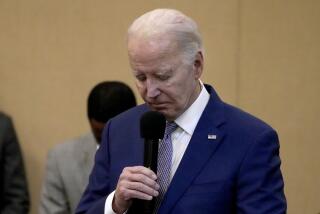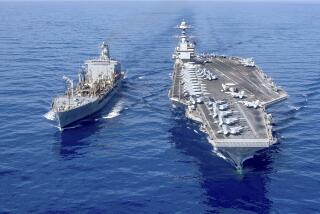U.S. May Need New Battle Plan, Experts Say
- Share via
WASHINGTON — The showdown with Iraq demonstrates that America’s support from its Persian Gulf allies has shrunk since the 1991 war and suggests that the United States may need a new battle plan for any renewed face-off with Iraqi President Saddam Hussein, analysts say.
Although Pentagon officials contend that they had all the military assistance they required in the latest confrontation, neither Saudi Arabia nor Turkey agreed to let warplanes fly from its bases. Even Bahrain, where American B-1B Lancer bombers are based, showed last-minute ambivalence about the mission.
Taken together, these reactions showed a sharp falloff of support in the seven years since the United States led a coalition of nations against Hussein, experts say. And they suggest that the U.S. should be prepared to lean more heavily on carrier-based warplanes and long-range bombers--and less on aircraft flying from nearby land bases--if there is another confrontation, as many officials expect.
“This was another test of the coalition, and we found out it was not terribly strong,” said Kenneth Pollack, a Mideast expert and former U.S. official now at the Washington Institute for Near East Policy. Military planners “have to be thinking, ‘If we need to do this again, how can we take all of this into account?’. . . It must have all come as something of a surprise,” he said.
Land-based warplanes let the military deliver more punch more quickly, through the use of radar-evading “stealth” aircraft and various radar-suppressing electronic aircraft. For this operation, the Pentagon was prepared to use F-117A Stealth fighters based in Kuwait and heavy B-1B bombers in Bahrain, as well as heavy B-52 bombers based 3,000 miles away in Diego Garcia, a British-controlled island in the Indian Ocean.
But in future operations, the Pentagon might be forced to rely more on the F-14 Tomcat and F/A-18 Hornet aircraft based on carriers; these craft fly shorter distances and aren’t protected by planes with the same radar-suppressing capabilities.
If support from allies remained weak for any future confrontation, military planners might consider relying more heavily on B-52 bombers, as well as on the $2-billion-a-copy B-2 bomber, which can deliver its huge payloads from the United States. Despite its advocates in the Pentagon, the B-2 was not called on to take part in the recent mission.
The cool reaction of U.S. allies in the Gulf came a year and a half after a confrontation with Iraq that brought even stronger resistance from American allies in the region. In September 1996, these Gulf states uniformly turned down the Clinton administration when it sought to fly warplanes to strike Hussein, who had invaded the Kurdish northern sections of his country and taken the regional capital, Irbil.
When the U.S. failed to get help from a single Gulf state, it sent warplanes from Navy ships, fired dozens of cruise missiles and dispatched B-52 bombers from Guam--a 19-hour trip.
“Judged by what happened then, you’d have to say the administration has actually made some progress in this effort,” said Daniel Goure, an analyst at the Center for Strategic and International Studies in Washington.
U.S. officials say they could have carried out the kind of strikes contemplated in the current mission with even less reliance on land-based planes. For Operation Desert Thunder, the military was considering days of round-the-clock attacks against targets in Iraq.
But leaning more on naval forces and long-distance bombers inevitably creates other strains. To deploy two carriers to the Gulf for the current mission, for example, the Navy has had to leave the western Pacific without an aircraft carrier. Adding more carriers in a future mission would thus inevitably leave greater parts of the globe without the Navy’s greatest weapon.
More to Read
Sign up for Essential California
The most important California stories and recommendations in your inbox every morning.
You may occasionally receive promotional content from the Los Angeles Times.













